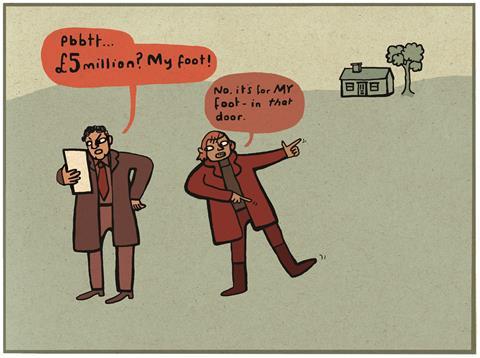A negligence case against a professional often, but not always, benefits from the opinion of an expert in the same field
Wanted … alive … expert witness of opinion. Isn’t it good to feel wanted … to be in demand? Actually, if you are in the mood to begin legal proceedings, arbitration, even adjudication against an architect, surveyor, engineer, get yourself an expert witness of opinion first.
Mr and Mrs Overall owned some land in Bourne End, Buckinghamshire; they hoped to get planning permission for a single bungalow and also get a “foot in the door”. ACD Landscape Architects was engaged for their planning application. That’s called a professional services contract. Professional because of good old fashioned professional snootyness about who sticks out above the rest. The landscaping architect did its best but the planning authority folk turned down the application. But Mr and Mrs Overall were keen to get their bungalow and their foot in the door approved. So they appealed. They brought in reinforcements. They paid out not only for our landscape architect professional but also for a planning barrister, a specialist planning solicitor, and hey-ho for a planning consultant. A whole army of professionals came. None of it worked. The appeal failed.
This case saw the lawyers defeat the strike-out by getting an expert report in the nick of time
Mr and Mrs Overall baulked at paying their architect’s bill. So he told his solicitor to sue. Back came the Overalls’ defence and counterclaim. The defence said that the professional had not only been in breach of contract but had been negligent as well. It was said that the landscape architect in his planning work ought to have produced a full “landscape and visual impact assessment”. The Overalls’ counterclaim for their “foot in the door” was a cool £5m alleged loss.
Now then, this is where you expert witnesses of opinion play a big role; or rather Mr and Mrs Overall should have engaged you for your expert opinion about the standard of care to be achieved by a person who calls himself a professional; more particularly a landscape architect professional. The Overalls’ defence and counterclaim had no expert report pinned to it. You can’t attempt to kick a professional in the shins unless an identical professional has said that he or she has fallen below the line of competence and hasn’t behaved to professional standards. Got it?
Well the lawyers for the landscape architect saw a knock-out blow become available to them. They applied to the court for what’s known as a strike-out. And if the court gives a thumbs up to that application that’s that; it’s all over for the Overalls. The idea of having to have an expert report to sue a professional is an embedded rule of practice. This is the second time in the space of a few months that this topic has come up. The first one saw the case stopped. This second one, ACD vs Overall, saw the lawyers for the Overalls defeat the strike out by getting an expert report in the nick of time. The reason it still came to court is because the Overalls were resisting paying the wasted costs of lawyers and court fees of the architect. The court said pay up.
You can’t attempt to kick a professional in the shins unless an identical professional has said that he or she has fallen below the line of competence
This so-called rule of must have an expert report is not rock-solid. The judge did outline circumstances that bring a professional negligence complaint that does not need an expert report from the outset. It’s when facts can be “pleaded” that indicate behaviour said to be below par and those facts stick out like a sore toe. And it’s likely to be in court that the judge will give a nod about the need for an expert report. In other words it’s not always necessary to spend out on an expert report so early on.
Eventually though the tribunal will want to hear about professional standards. “It takes one to know one” - provided the fellow professional isn’t a competitor in the same arena.
What about that foot in the door? Fascinating move here. The Overalls claimed that the negligence of the architect and failure to get planning for one bungalow lost them the glint they had in their eye to later re-apply for their site to have oodles more homes. Their site would then rocket in value to £5m. Won’t do said the court and struck that part of the claim out. The fee to be paid to the architect was for planning for one bungalow, and damages for negligence (if shown) only runs to the consequences related to that retainer. This is a good case for lawyers, arbitrators and adjudicators to read on professional negligence rather than going in feet first.

Tony Bingham is a barrister and arbitrator at 3 Paper Buildings Temple



























No comments yet